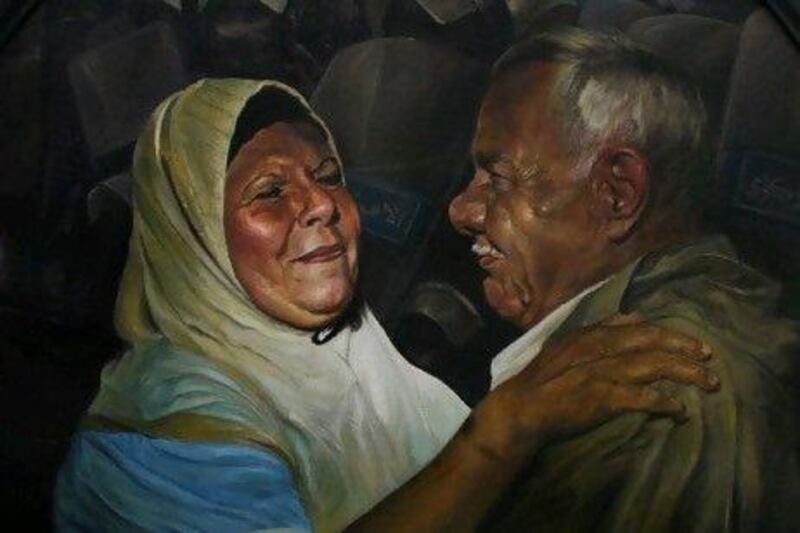Talking to Shadi Alzaqzouq means wading through an onslaught of words, provocations and calls to action. The Palestinian artist makes it clear that revolution and discontent are the primer for each of his canvases, which are currently exhibited in a show, titled National Clothesline, at Artspace in DIFC.
Born in Libya to Palestinians seeking refuge in the country, Alzaqzouq and his family were forced to up sticks again after the Oslo Accords when, he says, Muammar Qaddafi went on television to tell the Libyan people that peace had come to the Palestinian territories. "As a result, the people told us to go," says Alzaqzouq, turning around to show scars on the back of his head from that night.
He's now based in France, and movement and displacement are the sad undercurrents of the artist's otherwise combative paintings. Circular frames have been wrought out of tyres, a number of works have faceless cities in their backgrounds and he adorns his images in verbs of disappearance.
These verbs caused Alzaqzouq's work to face a mini-media storm during Art Dubai this year when a painting, depicting a woman wearing a bandanna and holding up a pair of underpants with "leave" in Arabic scrawled across them, drew the ire of the authorities.
After Washing was swiftly removed from Artspace's booth. "I didn't understand why," says Alzaqzouq, who also tells us that he was unable to get a visa to Dubai in time for the fair or again for this recent solo show. "It's not a political piece. It's really about life. But at the same time, something made me happy. I understood why I do work like this: for provocation. I am with the revolution, so this is what I'm about. This is action."
Exactly what the revolution he's referring to is never quite clear. Rather, it's more a general, globalised mood of discontent that he initially seems to champion in this show.
National Clothesline depicts a group of women hanging out laundry scrawled with "leave" or "go" in a multitude of languages. The setting is a courtyard at the centre of a particularly grim yet anonymous concrete housing complex. It's a black night and could almost be dystopian in vision were it not so common in the suburbs of big cities.
Airing out all this written-on laundry posits echoes between the Arab Spring and, particularly, given the Slavic floral bandannas and presence of the Cyrillic alphabet, the anti-Putin riots in Russia last year. "I like to talk about justice and I don't care about where that comes from. One hand clapping can't make a sound," says the artist.
A rogues' gallery of punks with Mohicans, anonymous souls in Guy Fawkes masks (of V For Vendetta fame) and bandannas across their faces line the walls. Yet everyone is gagged somehow - their bandit get-up forces them into silence. Therein lies the paradox in these works: it's hard to know what we're supposed to take as celebration and what we're supposed to take as satire. Alongside all those idealistic faces and arm-raising, there's The Free Thinker, a laboriously drawn self-portrait, clad only in boxer shorts and wearing a camo helmet with clown-like hair. Some strange tension exists between the gung-ho trappings of rebellion and an inconclusive end result in these images. Take the image of a woman wrapped head to toe in a blue veil, selling cans of spray paint and staring austerely at the viewer from exaggeratedly large spectacles. A title such as Revolution's Ghost would seem to suggest some fears of a growing conservatism after the region's upheaval. But Alzaqzouq is dismissive of that sort of reading, citing western fears of Islam as the work's inspiration.
However frothy the ideas behind these works may be, it shows a strikingly more political streak compared to artists that Artspace tends to represent. "People see this raw element in Shadi's work and that it is very much of the now," says Sossy Dikijian, the art director at Artspace. "The technicality of the works is also interesting in terms of this photorealist style of painting."
Varied work emerged in response to the Arab uprisings last year, some good, some less so. Alzaqzouq's work - however much he bellows its anarchic spirit at us - is less obtuse in stating what he's getting at and this makes the work all the better for it.
Until October 28 at Artspace, Gate Village, DIFC. Visit www.artspace-dubai.com or call 04 323 0820
Two other exhibitions at DIFC this week
Cuadro Fine Art Gallery
Three beefy solo shows this month: Manal Al Dowayan's large-scale prayer beads, new paintings by the British-Iraqi artist Athier Mousawi that explore the notion of progress in the Arab World and a photographic look at the interiors of prayer rooms found across the UAE by Ammar Mohammed Al Attar.
Until October 25
Artsawa
Painting with melted Plasticine, the Argentine collective Mondongo are set to present less explicit works in their Dubai showing than they've become known for, but are still a boisterous voice from afar.
Until October 28










